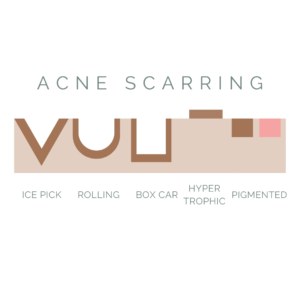What is acne scarring?
To truly understand what acne scarring is, you first must understand what scarring is. Scarring is defined by the fibrous process in which new collagen is formed to heal a full thickness (affecting more than one of the skins layers) injury.
Acne scarring usually affects those with moderate to severe acne vulgaris, it can also be associated with nodulocystic acne lesions, acne conglobata, acne fulminans, acne excoriae or prolonged infantile acne.
Ultimately early intervention with acne treatments can reduce the severity of acne scarring.
Acne scarring can present anywhere there were acne lesions. The types of acne scarring is largely dependant on your skins ability to heal itself following the formation of an acne lesion. Patients who are more prone to scarring or have a family history of keloid scars are more likely to develop acne scarring. It is not uncommon to have a variety of acne scar types.
What are the different acne scarring types?
Ice pick are one of the most common types of acne scars. The have a very small diameter, sharp edges and go quite deep into the skin. Some ice pick scars have the appearance of an enlarged pore. Ice pick scars are wider at the skins surface than at the complete depth of the scar. These scars are most commonly found on the forehead and cheeks. This is usually due to the fact that the skin is thinner in these locations. Ice pick scars are one of the hardest scar types to treat.

Rolling scars are as the name suggests they roll through the skin. These scars do not have a well defined edge rather “roll” or have sloping edges. This gives the skin a very uneven appearance. Rolling scars tend to appear where the skin is thicker on the face (jawline and lower cheeks).
Box Car scars have a more obvious edge with it appearing very sharp. These scars can be a couple of millimeters wide and can be classed as a deeper acne scar type. Like rolling scars box car scars tend to be located in thicker skin areas like the lower cheeks and jawline.
Hypertrophic and Keloid are classed as a raised scar type. Hypertrophic scars will be identical to the acne lesion that caused the scar to form whilst keloid scars will be larger than the original lesion. These scars are caused by an overgrowth of fibrous tissue. Hypertrophic and Keloid scars are more likely to be located on the chest, back and shoulders where the skin is thickest. It is also not uncommon for these scars to be located on the face especially the jawline. This scar type is more likely in patients with a darker skin type.
Some scars may cause Pigment changes or skin discolouration. This discolouration can either be caused by an increase in blood vessels to the area during the healing phase which will be likely to cause increased redness or purple. Alternatively sometimes brown discolouration occurs following an acne lesion this is caused by an increase in melanin caused by the trauma. For some patients the discolouration will heal with time, for other patients unfortunately this can become a little more persistent and even permanent. The discolouration can occur anywhere that acne forms.
What treatment options are there for acne scars?
- Chemical Peels
- Laser
- Fractionated
- Ablative
- Radiofrequency
- Steroid Injections
- Microneedling
- Subscision
- Dermal Fillers

